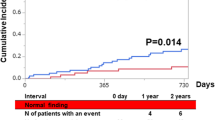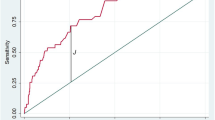Abstract
Background
This study examined the prognostic value of adenosine single-photon emission computed tomographic thallium imaging in medically treated patients with angiographic evidence of coronary artery disease (CAD).
Methods and Results
Patients who underwent coronary revascularization within 3 months of this study were excluded. There were 177 patients aged 64±11 years; 74 had one-vessel, 57 had two-vessel, and 46 had three-vessel CAD (>-50% diameter stenosis). During a mean follow-up of 22±13 months, there were 14 events (cardiac death or nonfatal myocardial infarction). Cox survival analysis with important clinical, catheterization, and scintigraphic variables identified the size of perfusion abnormality as the strongest predictor of events (x2=9). Life-table analysis showed that patients with perfusion defects of 15% or greater of the myocardium had a worse prognosis than had patients with no or smaller defects (Mantel-Cox statistic =13;p<0.001).
Conclusions
Thus adenosine single-photo emission computed tomographic thallium imaging provides important prognostic data in medically treated patients with CAD. The extent of thallium abnormality is the most important predictor of events.
Similar content being viewed by others
References
Iskandrian AS. Thallium-201 myocardial imaging and radionuclide ventriculography. In: Iskandrian AS, ed. Nuclear cardiac imaging principles and applications. Philadelphia: Davis, 1986:81–161.
Heo J, Iskandrian AS. Stress thallium imaging. Am J Noninvas Cardiol 1991;5:173–84.
Staniloff HM, Forrester JS, Berman DS, Swan HJC. Prediction of death, myocardial infarction and worsening chest pain using thallium scintigraphy and exercise electrocardiography. J Nucl Med 1986;27:1842–8.
Iskandrian AS, Heo J, Decoskey D, Askenase A, Segal BL. Use of thallium-201 imaging for risk stratification of elderly patients with coronary artery disease. Am J Cardiol 1988;61:269–72.
Iskandrian AS, Heo J, Kong B, Lyons E. Effect of exercise level on the ability of thallium-201 tomographic imaging in detecting coronary artery disease: analysis of 461 patients. J Am Coll Cardiol 1989;14:1477–86.
Brown KA, Boucher CA, Okada RD, Guiney TE, Newell JB, Strauss HW. Prognostic value of exercise thallium-201 imaging in patients presenting for evaluation of chest pain. J Am Coll Cardiol 1984;1:994–1001.
Boucher CA, Brewster DC, Darling RC, Okada RD, Strauss HW, Pohost GM. Determination of cardiac risk by dipyridamole-thallium imaging before peripheral vascular surgery. N Engl J Med 1985;312:389–94.
Hendel RD, Layden JJ, Leppo JA. Prognostic value of dipyridamole-thallium scintigraphy for evaluation of ischemic heart disease. J Am Coll Cardiol 1990;15:109–16.
Verani MS, Mahmarian JJ, Hixson JB, Boyce TM, Staudacher RA. Diagnosis of coronary artery disease by controlled coronary vasodilation with adenosine thallium-201 scintigraphy in patients unable to exercise. Circulation 1990;82:80–7.
Nguyen T, Heo J, Ogilby D, Iskandrian AS. Single photon emission computed tomography with thallium-201 during adenosine-induced coronary hyperemia: correlation with coronary arteriography, exercise thallium imaging and two-dimensional echocardiography. J Am Coll Cardiol 1990;16:1375–83.
Siffring PA, Gupta NC, Mohiuddin SM, et al. Myocardial uptake and clearance of adenosine-induced hyperemia and exercise stress. Radiology 1989;173:769–74.
Cave V, Heo J, Cassel D, Iskandrian B, Iskandrian AS. Side effects during adenosine thallium imaging with single port or double port infusion protocol. Am Heart J 1992;124:610–3.
Iskandrian AS, Heo J, Askenase A, Segal BL, Helfant RH. Thallium imaging with single photon emission computed tomography. Am Heart J 1987;114:852–65.
Iskandrian AS, Heo J, Nguyen T, Lyons E, Paugh E. Left ventricular dilatation and pulmonary thallium uptake after single photon emission computer tomography using thallium-201 during adenosine-induced coronary hyperemia. Am J Cardiol 1990;66:807–11.
SAS user’s guide: statistics. 5th ed. North Carolina: Gary, SAS Institute, 1985.
Iskandrian AS, Heo J, Nguyen T, et al. Assessment of coronary artery disease using single photon emission computed tomography with thallium-201 during adenosine-induced coronary hyperemia. Am J Cardiol 1991;67:1190–4.
Abreu A, Mahmarian JJ, Nishimura S, Boyce TM, Verani MS. Tolerance and safety of pharmacologic coronary vasodilation with adenosine in association with thallium-201 scintigraphy in patients with suspected coronary artery disease. J Am Coll Cardiol 1991;18:730–5.
Iskandrian AS, Chae SC, Heo J, Stanberry CD, Wasserleben V, Cave V. Independent and incremental prognostic value of exercise single-photon emission computed tomographic (SPECT) thallium imaging in coronary artery disease. J Am Coll Cardiol 1993;22:665–70.
Kaul S, Lilly DR, Gascho J, et al. Prognostic utility of the exercise thallium-201 test in ambulatory patients with chest pain: comparison with cardiac catheterization. Circulation 1988;77:745–58.
Kaul S, Finkelstein DM, Homma S, Leavitt M, Okada RD, Boucher CA. Superiority of quantitative exercise thallium-201 variables in determining long-term prognosis in ambulatory patients with chest pain: a comparison with cardiac catheterization. J Am Coll Cardiol 1988;12:25–34.
Landenheim ML, Pollock BH, Rozonoski A, Berman DS, Staniloff HM, Diamond GA. Extent and severity of myocardial hypoperfusion as predictors of prognosis in patients with suspected coronary artery disease. J Am Coll Cardiol 1986;7:464–71.
Ong L, Green S, Reiser P, Marrison J. Early prediction of mortality in patients with acute myocardial infarction: a prospective study of clinical and radionuclide risk factors. Am J Cardiol 1986;57:33–8.
Coyne EP, Belvedere DA, Vande Streek PR, Evans RB, Spaccavento LJ. Thallium-201 scintigraphy after intravenous adenosine infusion compared with exercise thallium testing in the prognosis of coronary artery disease. J Am Coll Cardiol 1991;17:1289–94.
Gill JB, Ruddy TD, Newell JB, Finkelstein DM, Strauss HW, Boucher CA. Prognostic importance of thallium uptake by the lungs during exercise in coronary artery disease. N Engl J Med 1987;317:1485–9.
Boucher CA, Zir LM, Beller GA, et al. Increased lung uptake of thallium-201 during exercise myocardial imaging: clinical, hemodynamic and angiographic implications in patients with coronary artery disease. Am J Cardiol 1980;46:189–96.
Kushner FG, Okada RD, Kirshenbaum HD, Boucher CA, Strauss W, Pohost GM. Lung thallium-201 uptake after stress testing in patients with coronary artery disease. Circulation 1981;63:341–7.
Wilson RA, Okada RD, Boucher CA, Pohost GM. Radionuclide-determined changes in pulmonary blood flow volume and thallium lung uptake in patients with coronary artery disease. Am J Cardiol 1983;51:741–8.
Gibson RS, Watson DD, Carabello BA, Holt ND, Beller GA. Clinical implication of increased lung uptake of thallium-201 during exercise scintigraphy two weeks after myocardial infarction. Am J Cardiol 1982;49:1586–93.
Nishimura S, Mahmarian JJ, Verani MS. Significance of increased lung thallium uptake during adenosine thallium-201 scintigraphy. J Nucl Med 1992;33:1600–7.
Patterson RE, Kirk ES. Coronary steal mechanism in dogs with one-vessel occlusion and other arteries normal. Circulation 1983;67:1009–15.
Author information
Authors and Affiliations
Additional information
During the period of this study, Drs. Kamal and Fattah were on sabbatical from their posts at the Universities of Monufia and Cairo in Egypt, respectively.
Rights and permissions
About this article
Cite this article
Kamal, A.M., Fattah, A.A., Pancholy, S. et al. Prognostic value of adenosine single-photon emission computed tomographic thallium imaging in medically treated patients with angiographic evidence of coronary artery disease. J. Nucl. Cardiol. 1, 254–261 (1994). https://doi.org/10.1007/BF02940339
Received:
Accepted:
Issue Date:
DOI: https://doi.org/10.1007/BF02940339




